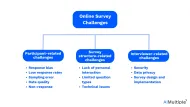Online surveying helps companies understand the trends in the market and customers’ needs. That’s why understanding its scope is crucial in implementing it in your research practices.
To give an idea regarding the effectiveness of surveys, Here we review the statistics regarding
- Market size,
- Effect of the region,
- Online survey trends,
- Effect of incentivizing participants on the quality of the survey.
If you are looking for a survey tool, check our our vendor selection guide.
Market size
1- The market research services industry is estimated to be worth $84 billion in 2023, and it is expected to exceed $90 billion in 2025.1
2- Online survey software market is expected to reach almost $5 billion by 2026.2
3- Based on our data-driven research, we have found that survey tools were searched 132k times in 2021 on search engines, x17 times more than other product-based solutions in the market.
4- Most applications of online survey software are market research, retail, financial services, healthcare, and manufacturing.3
Regional statistics
5- The average response rates of web-based surveys are as follows:4
The US: 46%
UK: 36%
The Netherlands: 33%
6- Research shows that almost 55% of Internet users live in the Asia Pacific region, followed by June 2022, which is the fastest-growing region and can be a great opportunity to understand the market and the customers’ needs.5
7- The largest market in 2021 for online survey services is North America.6
8- In the U.S., the largest portion of research financing based on methods goes to quantitative research, representing 59%, while reporting receives 24%, and qualitative research makes up 18%.7
Check out the challenges of conducting online surveys and our solutions.
Online survey trends
9- In the 2022 worldwide market research sector, 36% of firms used social media analytics, and 28% regularly employed mobile-first surveys.8
10- 40% of marketing professionals believe that in ten years’ time, AI will possess the capability to understand survey data as effectively as human analysts.9
Check out our article on how ChatGPT help creating surveys for market researchers.
Survey participants
11- The most common challenges of conducting surveys related to the survey participants are response bias, low response rates, sampling error, data quality, and non-response.
To learn more about survey participant recruitment, check out our article.
12- A high quantity of survey participants does not necessarily translate to superior data quality.
13- Research demonstrates that, in the absence of incentives, 60% of people answer questions indifferently or arbitrarily.
14- Incentivizing people with vouchers can increase the response rate by 7% without any decrease in data quality.10
15- However, according to additional research, individuals in the high-pay condition were more motivated to attempt to complete the survey than those in the low-pay condition.11
16- According to a study, inquiries regarding one’s financial situation and contact information, such as phone numbers, are the most delicate.
17- People increasingly hesitate to respond as the question’s sensitivity rises in a survey.
18- Studies indicate that 95% of B2B enterprises utilize surveys to assess customer opinions and feedback.
19- ~90% of businesses claim to consider their customers’ feedback when creating new products.
Customer Reviews
20- Our research showed that while describing survey recruitment services, 17% of customers used the word “easy to use.”
21- While 31% of respondents give affective reactions to traditional online surveys with Likert scales, surveys powered by game mechanics (i.e., gamification) get reactions from 69% of respondents.12
22- There are another 26 dissatisfied customers for every satisfied customer, and companies can only hear from 4% of their customers’ complaints.13
For those interested, here is our data-driven list of survey participant recruitment services and survey tools.
Here is also our data-driven list of market research tools.
Further Reading
- 5 Best Google Survey Alternatives: Analysis of 30k+ Reviews
- Zoho Survey Evaluation & Top 10 Survey Tool Alternatives
- Top 7 Customer Survey Software
- Top 5 Pollfish Survey Tool Alternatives
If you need any assistance, do not hesitate to contact us:
External Links
- 1. “The Market Research Services Market Adapts To Digital Consumerism With The Impact Of COVID As Per The Business Research Company’s Market Research Services Global Market Report 2021”. The Business Research Company. November 18, 2021. Retrieved November 1, 2022.
- 2. Giving Intelligence Teams an AI-powered advantage.
- 3. internetworldstats.com.
- 4. A Meta-Analysis of How Country-Level Factors Affect Web Survey Response Rates - Jessica Daikeler, Henning Silber, Michael Bošnjak, 2022 .
- 5. internetworldstats.com.
- 6. Giving Intelligence Teams an AI-powered advantage.
- 7. Market research spend by research method U.S. 2022| Statista. Statista
- 8. Market research industry: emerging research approaches used| Statista. Statista
- 9. “How AI will reinvent the market research industry.” Qualtrics. Retrieved January 4,2023.
- 10. The Effectiveness of Incentives on Completion Rates, Data Quality, and Nonresponse Bias in a Probability-based Internet Panel Survey - Marshica Stanley, Jessica Roycroft, Ashley Amaya, Jill A. Dever, Anup Srivastav, 2020 .
- 11. Lie for a Dime - Jesse J. Chandler, Gabriele Paolacci, 2017 .
- 12. ScienceDirect.
- 13. 107 Customer Service Statistics and Facts You Shouldn't Ignore.



Comments
Your email address will not be published. All fields are required.